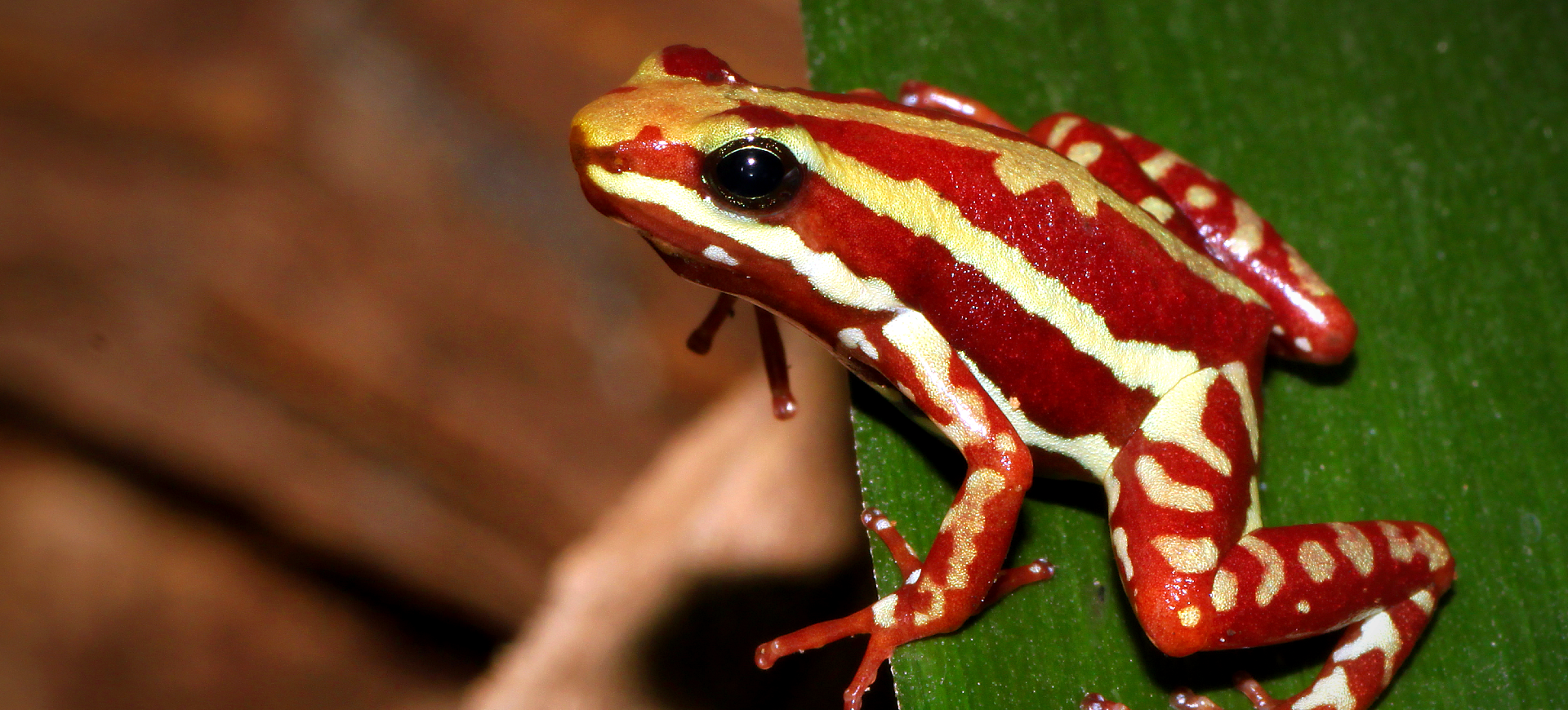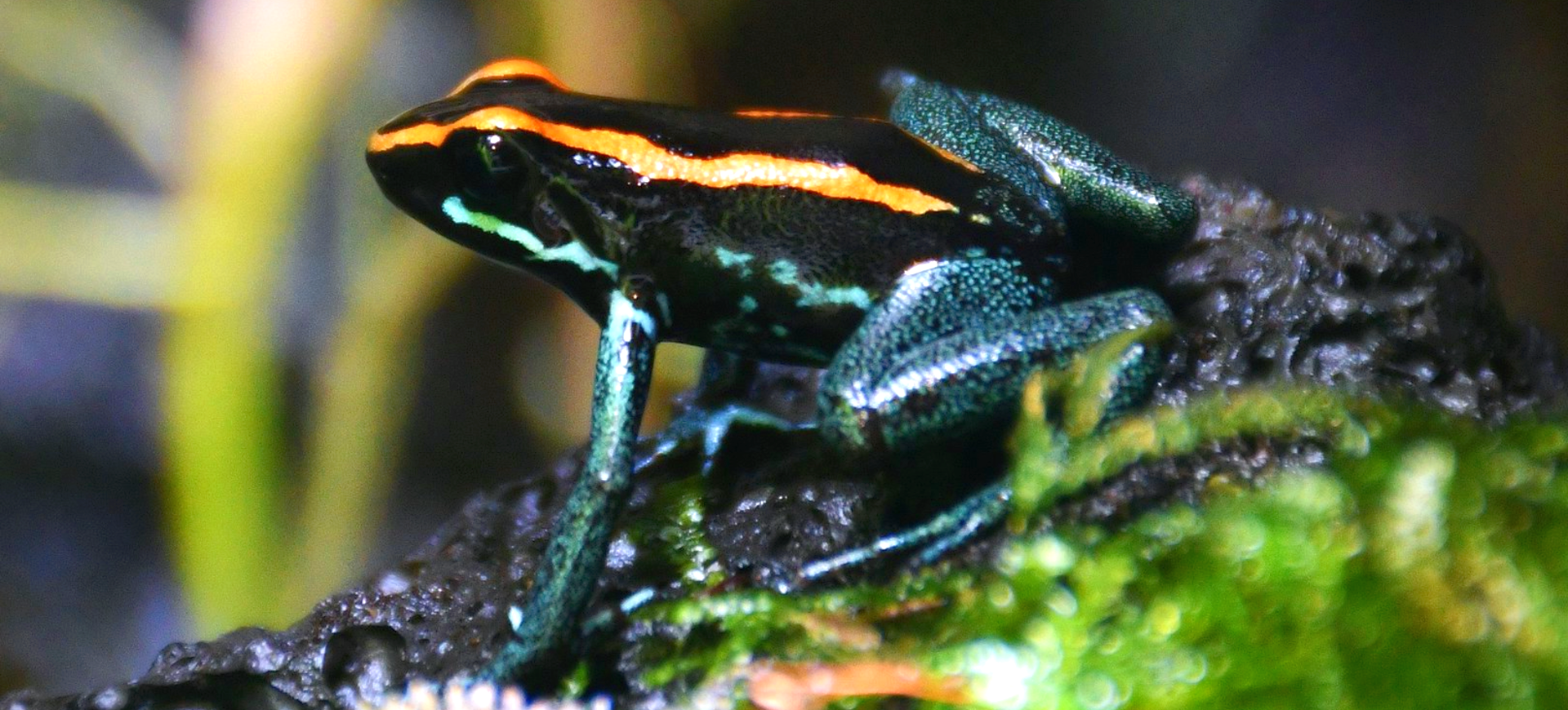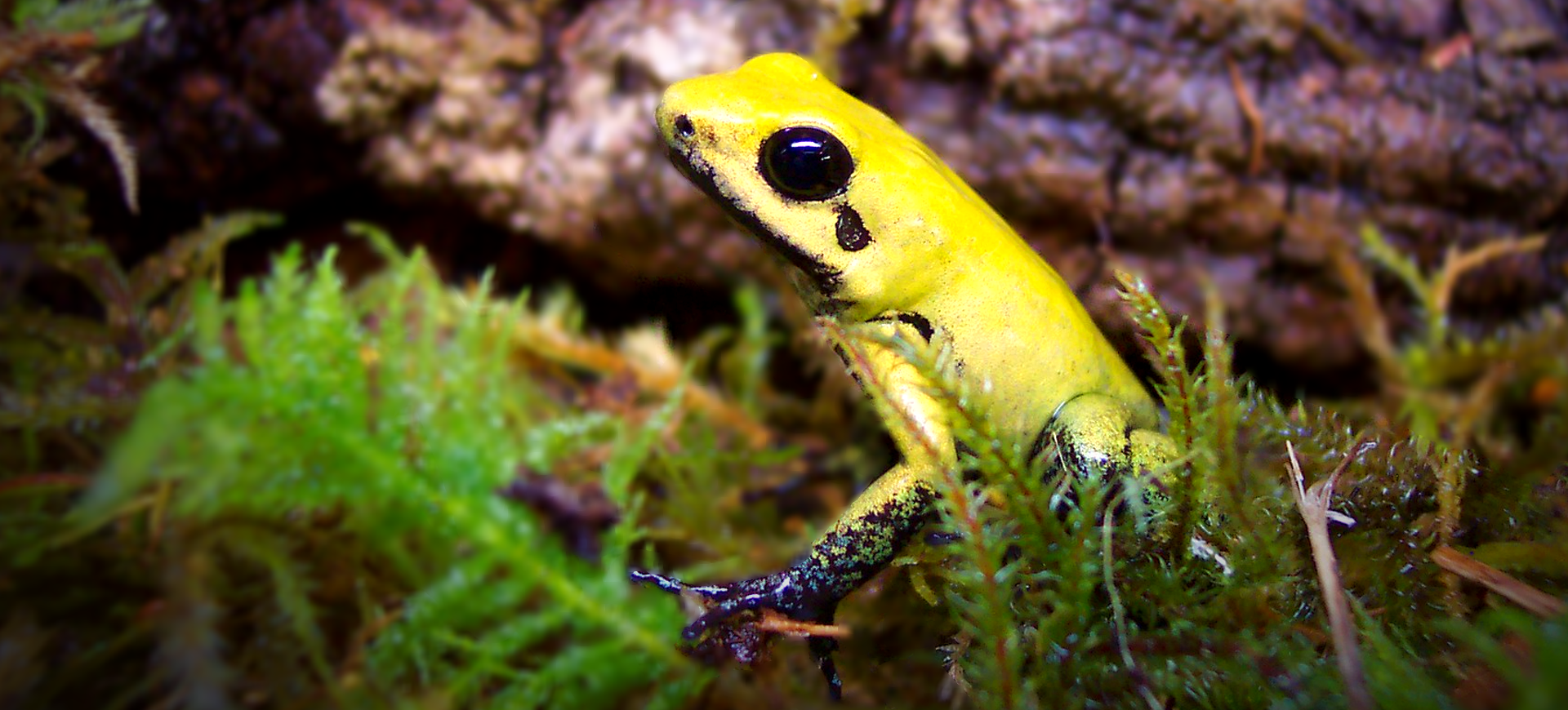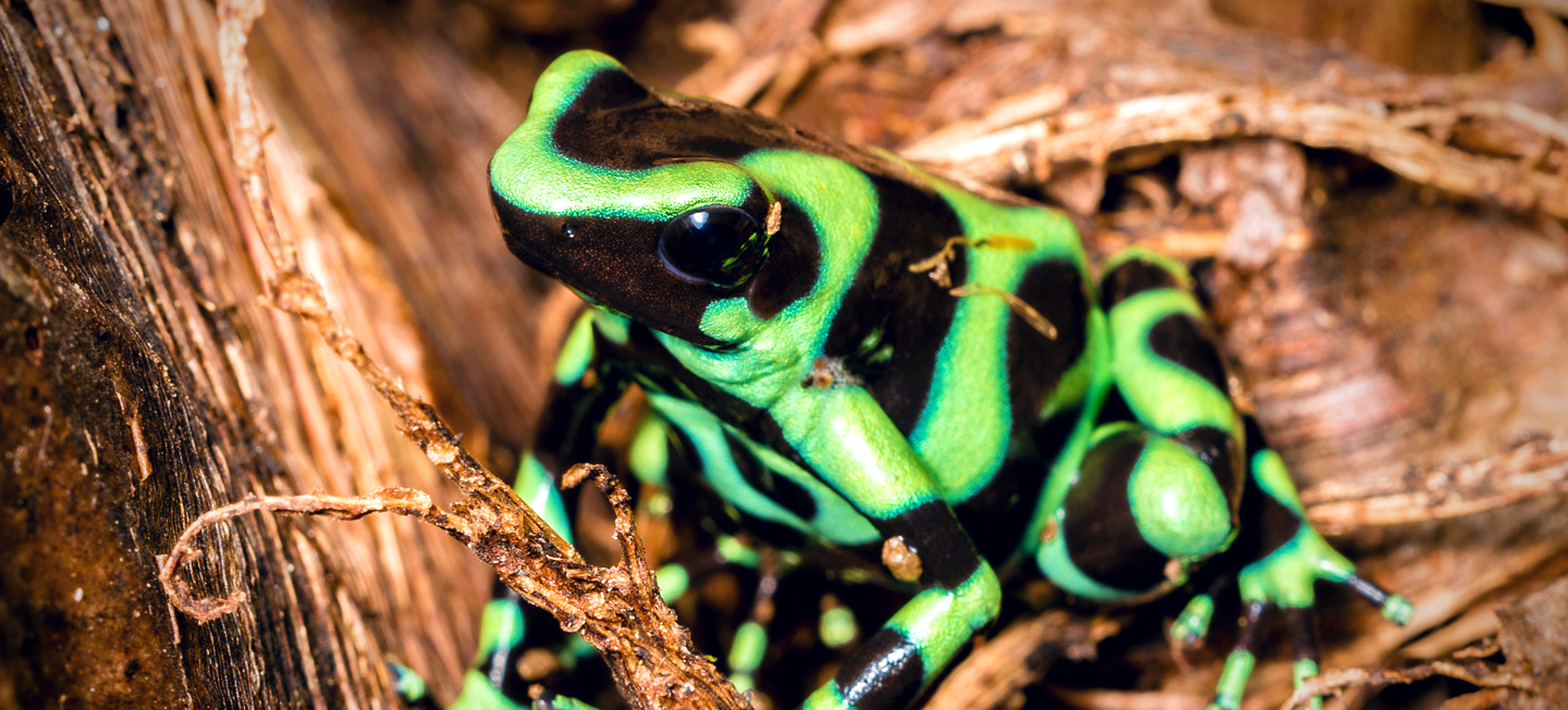Overview
The Dyeing Poison Dart Frog is a vibrant, medium-sized amphibian native to the rainforests of South America, particularly in the Guianas and parts of Brazil. Known for its striking coloration, ranging from turquoise to cobalt blue with black spots, this frog is a classic example of aposematism, where bright colors warn predators of toxicity.
The species is primarily terrestrial, spending most of its time on the forest floor, although it can climb trees and shrubs. It is diurnal, active daily, and feeds on various small insects. The Dyeing Poison Dart Frog is known for its complex vocalizations, serving as mating calls and territorial signals.
In the wild, the Dyeing Poison Dart Frog faces threats from habitat loss and the pet trade. However, it is not currently listed as endangered. Captive breeding programs have successfully reduced the pressure on wild populations, although illegal collection still occurs.
Taxonomy
Kingdom
Phylum
Class
Order
Family
Genus
Species
Type
Physical Description:
The Dyeing Poison Dart Frog is a medium-sized frog, typically measuring 1.5 to 2 inches long. It is known for its striking coloration, ranging from turquoise to cobalt blue, with black spots or bands. The bright colors serve as a warning to predators that the frog is toxic.
The skin of the Dyeing Poison Dart Frog is smooth and moist, aiding in respiration. The species has well-developed limbs, allowing it to move quickly and climb trees and shrubs. The eyes are large and forward-facing, providing a wide field of vision, which is crucial for spotting prey and avoiding predators.

Lifespan: Wild: ~5 Years || Captivity: ~20 Years

Weight: Male & Female: 0.2–0.5 oz (6–14 g)

Length: Male & Female: 1.5–2 in (3.8–5.1 cm)
Characteristic:
Native Habitat:
The Dyeing Poison Dart Frog is native to the rainforests of South America, particularly in the Guianas and parts of Brazil. It prefers humid, tropical environments with abundant vegetation, where it can easily find food and shelter. The species is well-adapted to these conditions, capable of surviving high humidity and temperature levels.
The Dyeing Poison Dart Frog is primarily terrestrial, spending most of its time on the forest floor. However, it can also climb trees and shrubs, where it may find additional food sources or escape from predators. The species is known to be territorial, with males defending their areas from rivals.
Climate Zones:
Biomes:
WWF Biomes:
Biogeographical Realms:
Continents:
Diet:
Diet & Feeding Habits:
The Dyeing Poison Dart Frog is an insectivore, primarily feeding on small insects like ants, termites, and fruit flies. It uses its long, sticky tongue to capture prey, which is then swallowed whole. The toxins in the frog’s skin are derived from its diet, particularly the ants it consumes.
In captivity, the Dyeing Poison Dart Frog is often fed a diet of crickets and fruit flies, supplemented with vitamins and minerals. It is essential to provide a balanced diet to meet its nutritional needs. The species is known for its hearty appetite and will readily accept a variety of insects.
Mating Behavior:
Mating Description:
The Dyeing Poison Dart Frog has a distinct mating behavior, usually during the rainy season. Males perform elaborate vocalizations to attract females. Once a female is receptive, the male leads her to a suitable site, such as a leaf or a small pool of water, where she lays her eggs.
After laying the eggs, the male fertilizes them. Both parents take turns guarding the eggs until they hatch into tadpoles. The tadpoles are then carried on the backs of the parents to small pools of water, where they complete their development into juvenile frogs.
Reproduction Season:
Birth Type:
Pregnancy Duration:
Female Name:
Male Name:
Baby Name:
Social Structure Description:
The Dyeing Poison Dart Frog is generally a solitary animal, interacting with other individuals primarily during the mating season. Males are territorial and will defend their areas from rivals using a variety of displays, including vocalizations. While the species is not highly social, it does have a complex set of behaviors for communication, including body postures and vocalizations.
Dyeing Poison Dart Frogs can be kept together in captivity, although monitoring signs of stress or aggression are essential. Males should not be housed together, as they will fight for territory. Females can coexist more peacefully but should still be monitored for signs of stress or competition for resources.
Groups:
Conservation Status:
Population Trend:
The Dyeing Poison Dart Frog is not currently considered endangered but faces threats from habitat loss and the pet trade. It is a highly adaptive species, capable of surviving in various environmental conditions. It is a popular pet in captivity, known for its striking coloration and relatively easy care requirements.
Conservation efforts for the Dyeing Poison Dart Frog are primarily focused on habitat protection and sustainable pet trade practices. The species is also part of several captive breeding programs to reduce the pressure on wild populations. While it is not a focus of major conservation initiatives, ongoing monitoring is essential to ensure its long-term survival.
Population Threats:
The primary threats to the Dyeing Poison Dart Frog include habitat loss due to agriculture, logging, and the pet trade. While captive breeding has reduced the pressure on wild populations, illegal collection still occurs. In some areas, local populations have declined due to these pressures.
Efforts to combat these threats include habitat protection and sustainable pet trade practices. Education and awareness-raising are also crucial for the success of conservation initiatives. While the Dyeing Poison Dart Frog is not a focus of major conservation efforts, ongoing monitoring is essential to ensure its long-term survival.
Conservation Efforts:
Conservation efforts for the Dyeing Poison Dart Frog are primarily focused on habitat protection and sustainable pet trade practices. The species is also part of several captive breeding programs to reduce the pressure on wild populations. While it is not a focus of major conservation initiatives, ongoing monitoring is essential to ensure its long-term survival.
Education and awareness-raising are also crucial for the success of conservation initiatives. The Dyeing Poison Dart Frog is a popular pet, and responsible pet ownership can contribute to its conservation. Captive breeding programs have reduced the demand for wild-caught individuals, although illegal collection still occurs.
Additional Resources:
Fun Facts
- The Dyeing Poison Dart Frog is native to the Guianas and parts of Brazil.
- It is known for its striking coloration, which serves as a warning to predators.
- The species is an insectivore, primarily feeding on small insects.
- It is a popular pet, particularly in the United States and Europe.
- The Dyeing Poison Dart Frog is diurnal and active during the day.
- It has complex vocalizations used for mating and territorial displays.
- The species is capable of climbing trees and shrubs.
- It is part of ongoing conservation efforts, including habitat protection and captive breeding programs.
- The Dyeing Poison Dart Frog is not currently considered endangered.
- It is a monogamous species, with both parents participating in caring for the offspring.











